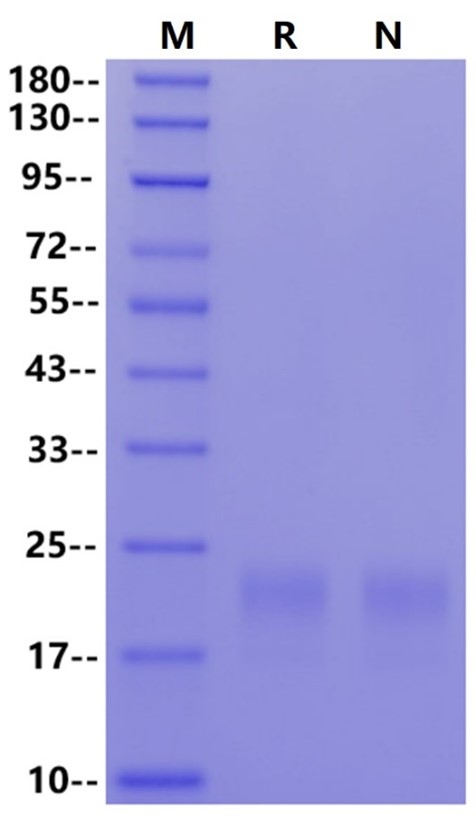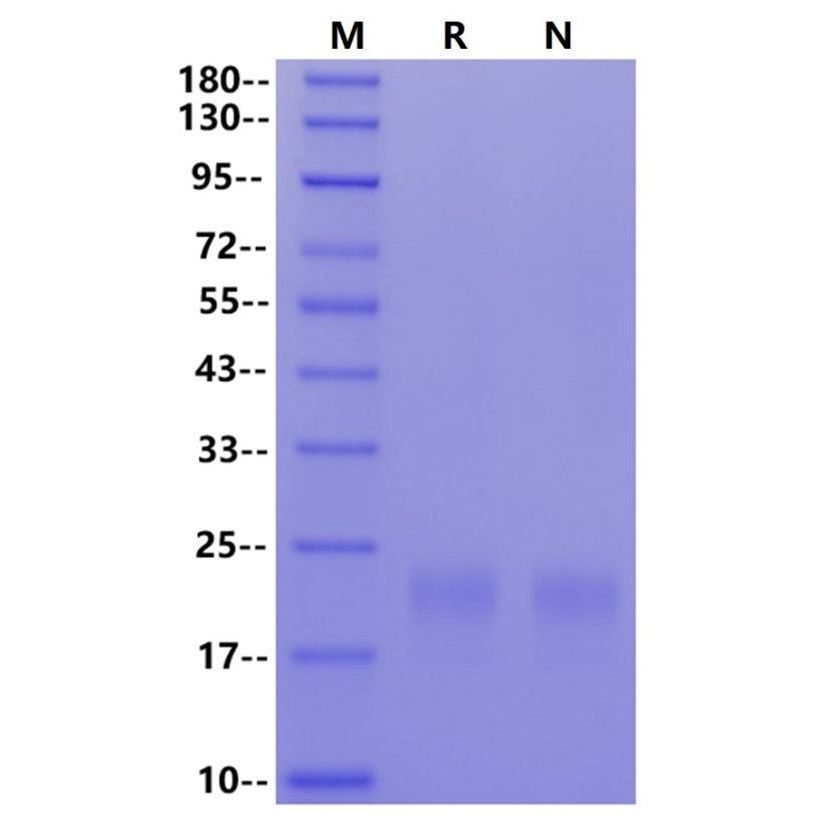Product Details
Product Details
Product Specification
| Species | Human |
| Synonyms | CEACAM3, CD66d, CEA, carcinoembryonic antigen-related cell adhesion molecule 3, CGM1, W264, W282 |
| Accession | P40198 |
| Amino Acid Sequence | Lys35-Gly155, with C-terminal 8*His KLTIESMPLSVAEGKEVLLLVHNLPQHLFGYSWYKGERVDGNSLIVGYVIGTQQATPGAAYSGRETIYTNASLLIQNVTQNDIGFYTLQVIKSDLVNEEATGQFHVYQENAPGLPVGAVAGGGGSHHHHHHHH |
| Expression System | HEK293 |
| Molecular Weight | 20-24kDa |
| Purity | >95% by SDS-PAGE |
| Endotoxin | <0.1EU/μg |
| Conjugation | Unconjugated |
| Tag | His Tag |
| Physical Appearance | Lyophilized Powder |
| Storage Buffer | PBS, pH7.4 |
| Reconstitution | Reconstitute at 0.1-1 mg/ml according to the size in ultrapure water after rapid centrifugation. |
| Stability & Storage | · 12 months from date of receipt, lyophilized powder stored at -20 to -80℃. · 3 months, -20 to -80℃ under sterile conditions after reconstitution. · 1 week, 2 to 8℃ under sterile conditions after reconstitution. · Please avoid repeated freeze-thaw cycles. |
| Reference |
1、Schmitter T. et al. (2007) The Granulocyte Receptor Carcinoembryonic Antigen-Related Cell Adhesion Molecule 3 (CEACAM3) Directly Associates with Vav to Promote Phagocytosis of Human Pathogens. The journal of immunology. 178: 3797-3805. 2、Swanson K V. et al. (2001) CEACAM is not necessary for Neisseria gonorrhoeae to adhere to and invade female genital epithelial cells. Cellular Microbiology. 3(10): 681-691. |
Background
Carcinoembryonic Antigen-related Cell Adhesion Molecule 3 (CEACAM-3), or CD66d, is part of the CEA protein family consisting of CEACAMs and the pregnancy-specific glycoproteins (PSGs). Both CEACAM and PSG molecules have been identified in humans and belong to the much larger glycosylphosphatidylinositol (GPI)-linked immunoglobulin (Ig) superfamily. Human CEACAM-3 is ~35 kDa, consisting of an extracellular domain (ECD) containing one IgV-like domain, a single transmembrane domain and a cytoplasmic tail. CEACAM family members are widely expressed in epithelial, endothelial, and hematopoietic cells, including neutrophils, T-cells, and NK cells. CEACAMs appear to be capable of transmitting signals that result in a variety of effects depending on the tissue, including tumor suppression, tumor promotion, angiogenesis, neutrophil activation, lymphocyte activation, regulation of the cell cycle, and regulation of adhesion. CEACAMs have now been associated with numerous intracellular signaling processes including cell adhesion, cell growth, recognition and differentiation, angiogenesis, and apoptosis. CD66d antibody increases neutrophil adhesion to the monolayer of human umbilical vein endothelial cells.
Picture
Picture
SDS-PAGE

1μg (R: reducing condition, N: non-reducing condition).


